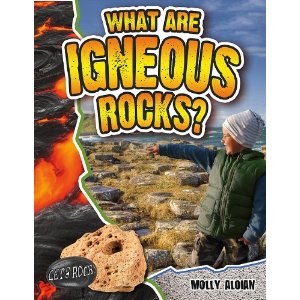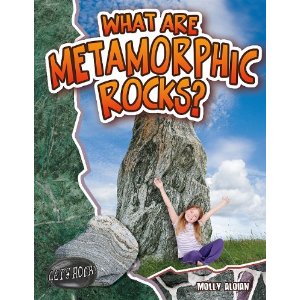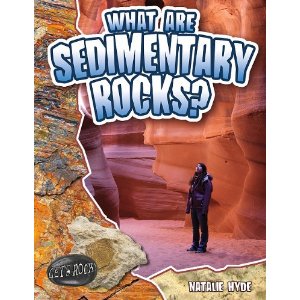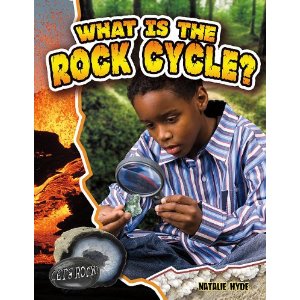| ________________
CM . . . . Volume XVII Number 18. . . .January 14, 2011. 
 |
What Are Igneous Rocks? (Let’s Rock).
Molly Aloian.
St. Catharines, ON: Crabtree, 2011.
32 pp., pbk. & hc., $9.95 (pbk.), $20.76 (RLB.).
ISBN 978-0-7787-7233-0 (pbk.), ISBN 978-0-7787-7228-6 (RLB.).
Subject Heading:
Igneous rocks-Juvenile literature.
Grades 4-6 / Ages 9-11.
Review by Gail Hamilton.
***/4
|
| |
|
 |
What Are Metamorphic Rocks? (Let’s Rock).
Molly Aloian.
St. Catharines, ON: Crabtree, 2011.
32 pp., pbk. & hc., $9.95 (pbk.), $20.76 (RLB.).
ISBN 978-0-7787-7234-7 (pbk.), ISBN 978-0-7787-7229-3 (RLB.).
Subject Heading:
Metamorphic rocks-Juvenile literature.
Grades 4-6 / Ages 9-11.
Review by Gail Hamilton.
***/4
|
| |
|
 |
What Are Sedimentary Rocks? (Let’s Rock).
Natalie Hyde.
St. Catharines, ON: Crabtree, 2011.
32 pp., pbk. & hc., $9.95 (pbk.), $20.76 (RLB.).
ISBN 978-0-7787-7235-4 (pbk.), ISBN 978-0-7787-7230-9 (RLB.).
Subject Heading:
Sedimentary rocks-Juvenile literature.
Grades 4-6 / Ages 9-11.
Review by Gail Hamilton.
***/4
|
| |
|
 |
What is the Rock Cycle? (Let’s Rock).
Natalie Hyde.
St. Catharines, ON: Crabtree, 2011.
32 pp., pbk. & hc., $9.95 (pbk.), $20.76 (RLB.).
ISBN 978-0-7787-7236-1 (pbk.), ISBN 978-0-7787-7231-6 (RLB.).
Subject Headings:
Petrology-Juvenile literature.
Geochemical cycles-Juvenile literature.
Grades 4-6 / Ages 9-11.
Review by Gail Hamilton.
***/4
|

excerpt:
Magma that pushes its way to the surface through cracks in Earth’s crust creates magma chambers and pipes, which create volcanoes. As the magma moves upward, the heat changes the rock it touches, but doesn’t melt it. This is called contact metamorphism.
When Earth’s tectonic plates collide, the rock can buckle and fold creating mountains. The farther down rock is pushed, the more heat and pressure is applied. Mountain building is the main source of metamorphic rocks. Because it happens over a large area, it is called regional metamorphism. (From What is the Rock Cycle?)
Four books comprise the new “Let’s Rock!” series which describes the various ways in which rocks are formed, their characteristics, such as mineral composition and colour, whether or not they contain fossils, and the ways in which humans use rocks to create both beautiful and useful objects. An attractive layout, catchy headings, and backgrounds resembling a rocky surface are very appealing. The main body of the text is enhanced by fact boxes as well as diagrams, maps, tables and wonderful colour photographs showing examples of rocks and rock formations from all parts of the world. In addition, readers can try several experiments to better understand the concepts presented. However, most of these experiments require adult supervision, and some of them might necessitate a trip to the store for a few inexpensive items. There is slight overlap from one title to the other, particularly in terms of diagrams, illustrations and the odd experiment, but this is not problematic. Words in boldface type appear in a glossary at the back of the book, along with an index and a list of books and web sites for further study. A table of contents is also included.
What Are Igneous Rocks? explains the origins of rocks “made from fire.” There are over 700 different kinds of igneous rocks, some of which form from magma below the Earth’s surface and others which form above the surface when lava cools and hardens. In this title, readers will learn about the Earth’s layers, the movement of tectonic plates that causes volcanoes to erupt, the types of volcanoes, and the difference between intrusive and extrusive rocks. Other topics include specific rocks, such as quartz, basalt and granite, the environmental impact of mining, and an explanation of sills and dikes, the former created when magma seeps into horizontal cracks between rocks and the latter created when it seeps into vertical cracks. Instructions are provided for several experiments, one of which is designed to show how lava flows and cools (using melted chocolate chips on waxed paper- rather a stretch), and others demonstrating how basalt “pillows” and sheets of obsidian are formed, just to name a few.
Metamorphic means “change of form.” The intense heat from magma causes new minerals to form in rocks that are nearby, altering the rocks’ characteristics. Another cause of metamorphism is the impact of an asteroid or comet colliding with the Earth. What Are Metamorphic Rocks? provides information about the three grades of regional metamorphism (each of them varying in temperature and pressure), foliation which causes a banded appearance, and several types of rocks and their transformation, which can include a change in colour, granularity and re-crystallization. Some examples of transformation are limestone to marble (used for sculptures), shale to slate (used for roofs, patios, floors and walkways), and granite to gneiss (used for memorials, statues, countertops and floor tiles). One of the featured experiments shows readers how extreme pressure removes fossils from rock, while another attempts to demonstrate how distance from a heat source affects rock formation (this one is a bit lame- the experimenter is asked to place three pieces of cookie dough on a hot barbecue grill at varying distances from the heat source, then watch what happens).
What are Sedimentary Rocks? provides information about the formation of these rocks by wind, water and glacial erosion, the transportation and deposition of sediment, and the difference between clastic sedimentary rocks (those formed from bits of other sedimentary rocks) and organic sedimentary rocks (those formed by the remains of plants and animals). Scientists are able to determine the geological age of the Earth through their analysis of the various layers of rock. In this title, readers will also find out about the formation of coral reefs, caves, coal and fossils. As well, they will be introduced to related terms such as deltas, moraines, floodplains, hoodoos, clints and ooids. Also featured are several famous buildings which have been made from limestone- Buckingham Palace in London, Notre Dame Cathedral in Paris, the Empire State Building in New York City and the Parliament Buildings in Ottawa.
General information about the characteristics of all three types of rocks can be found in What is the Rock Cycle? Other topics in this title include rock origins, erosion, volcanoes and their makeup, tectonic plates and their role in earthquakes and the formation of mountains, stalagmites and stalactites, and fossils. Experiments range from making a volcano to creating conglomerate “rock” and crystals. Finally, uses of various rocks are listed, some examples being granite countertops, pumice stones, buildings, cement, concrete, bridges, statues and fuel (coal). Much of the information in this title is provided in the other books, but in greater detail.
Educational, informative and interesting, this series has a place in the classroom or school library and dovetails very nicely with the rocks and minerals unit of the science curriculum.
Recommended.
Gail Hamilton is a retired teacher-librarian in Winnipeg, MB.

To comment on this title or this review, send mail to
cm@umanitoba.ca.
Copyright © the Manitoba Library Association. Reproduction for personal use is permitted only if this copyright notice is maintained. Any other reproduction is prohibited without permission.
NEXT REVIEW |
TABLE OF CONTENTS FOR THIS ISSUE- January 14, 2011.
AUTHORS |
TITLES |
MEDIA REVIEWS |
PROFILES |
BACK ISSUES |
SEARCH |
CMARCHIVE |
HOME |



